语法
本文整理自B站【英语兔】的教学视频,感兴趣的朋友可以自行前往观看。
动词语法框架
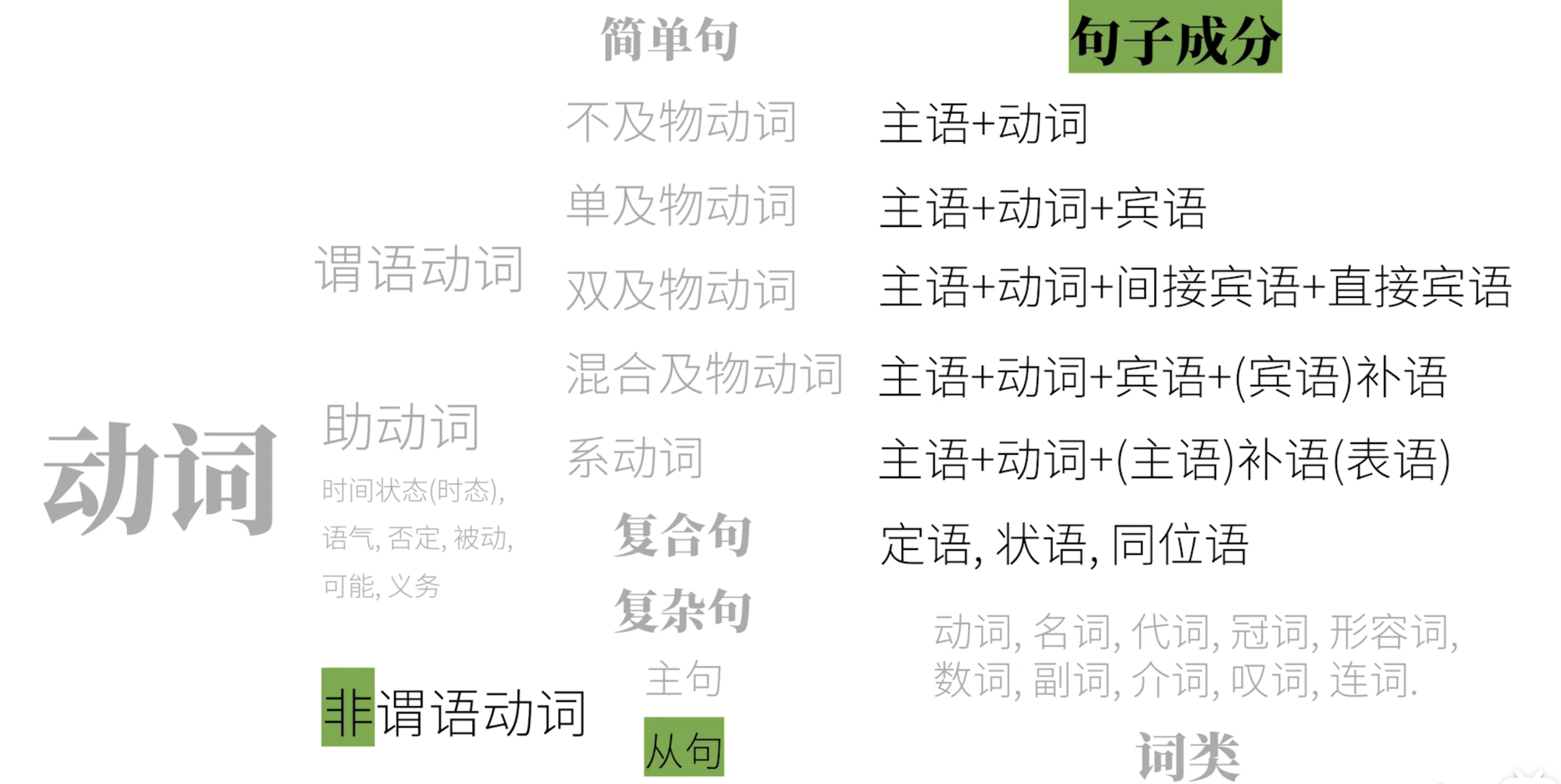
一、动词的分类
1.1、谓语动词(限定性动词)
1.1.1、实义动词
1、按动作承受者划分
- 及物动词
- 单及物动词
- 双及物动词
- 混合及物动词
- 不及物动词
2、按动作状态划分
- 动作动词
- 状态动词
1.1.2、系动词
可被划分为不及物动词或状态动词
系动词又叫连系动词,系动词的作用就是赋值,将系动词后面的词的含义赋予系动词前面的词
- the carrot smells nice smel系动词
- I smell something! Oh no, the carrot has gone bad. It smells. 第一个smel是及物动词,第二个smell是不及物动词
- The room remained empty.
- The sky grew dark.
其他系动词
- keep
- stay
- seem
- appear
- feel
- become
- turn
- prove
- ...
1.2、非谓语动词(非限定性动词)
一个简单句只能有一个谓语动词,可以表达【时体气】,而句中其他的动词需要以非谓语动词出现。
- 动词不定式
- 动词过去分词
- 动词现在分词
- 动名词
1.3、助动词
二、谓语动词 Predicate Verb
2.1、谓语动词的“三大本领TAM时体气”
- 表示动作的时间Tense
- 表示动作的状态Aspect
- 表示你动作的假设,情感等(动词语气Mood)
2.2、谓语动词的“时态”
2.2.1、时态说明
时态是由动词的时间+状态排列组合成的
1、状态说明
- 一般状态:句子中并没有直接说明句子的状态
- 进行状态:表示动作正在进行中
- 完成状态:表示动作已经完成了,多半不会继续了;完成状态并不直接说明动作的具体开始时间,
- 完成进行状态:表示动作的一部分完成了,但剩下的还在进行中
2、时间状态组合表
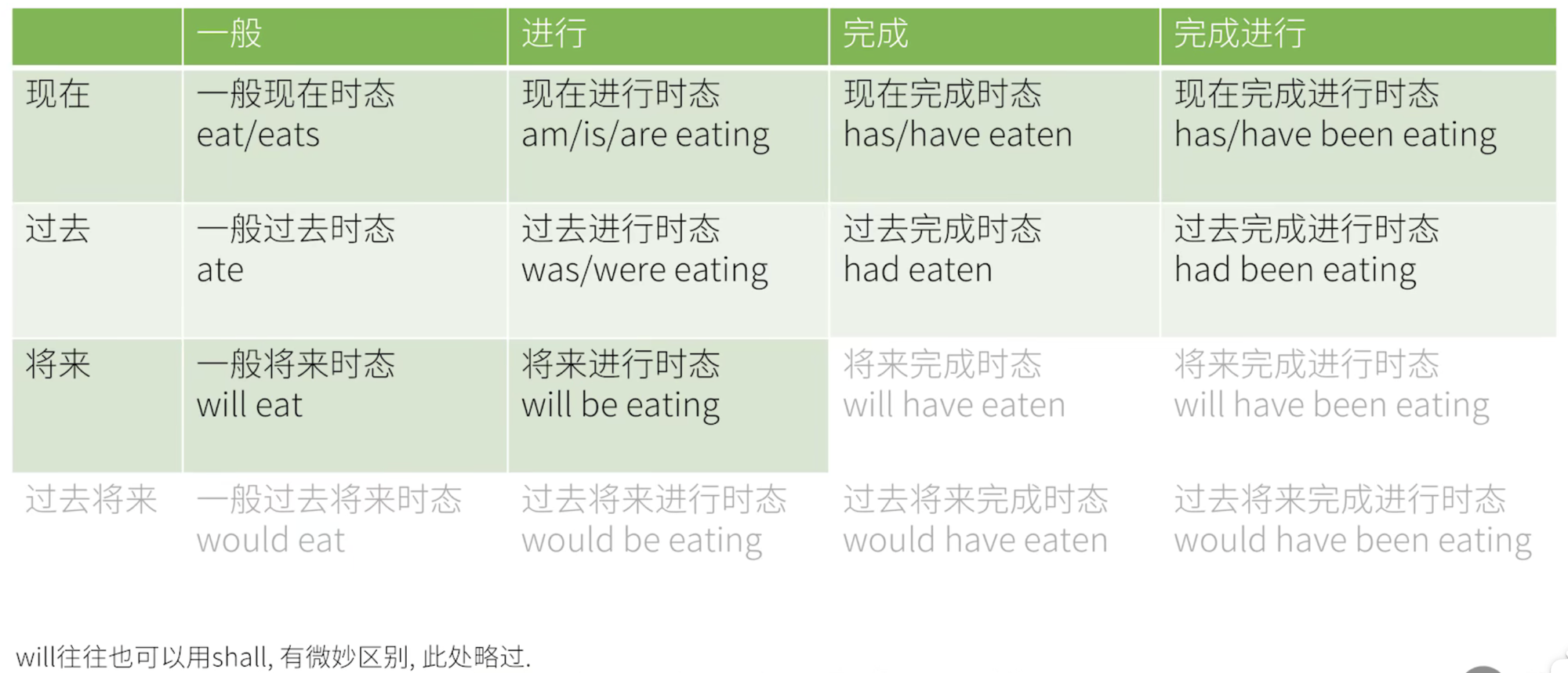

3、图解时态
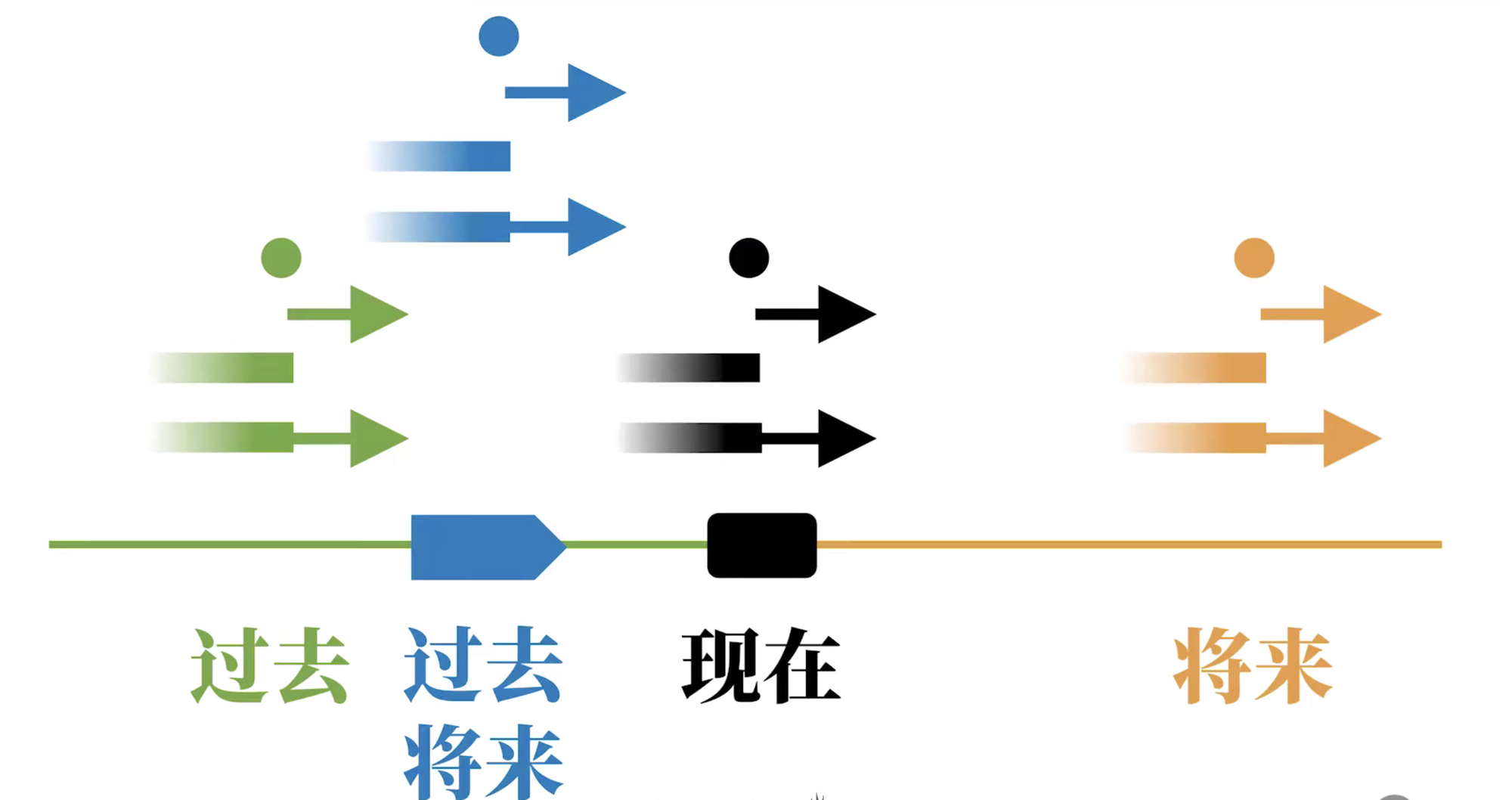

2.2.2、时态详解
1、现在
①、一般现在时态
- 时态结构:+ 动词原形 (如果主语是第三人称单数,动词需要加s)
- 例句:I eat carrots
常见的一般现在时
表达事实
- 表达进行中的动作不能用一般现在时态,如:
I eat a carrot,I go to lunch,一般现在时也不和now一起使用
例句
l eat carrots. 我吃胡萝卜:我是吃胡萝卜这种食物的。(这个是个事实陈述)
The rabbit eats carrots.免子吃胡萝卜:免子是吃胡萝卜的动物。(也是事实陈述)
The sun rises in the east. 太阳从东边升起.
The earth revolves around the sun. 地球绕太阳转.
表达习惯或重复的动作
- I play basketball. 我打篮球.(我有这个习惯)
表示预计发生的事
- The bus leaves at 8PM tonight
- The bus leaves at 8PM every day.公车每晚八点离站
②、现在进行时态
- 时态结构:助动词be的变位 + 动词的现在分词;此处be动词的变位是:am、is、are
- 例句:I am eating a carrot;You/we/they are eating a carrot;She/he/it is eating a carrot.
be动词的两个身份
- (连)系动词:把它之后的意思赋予前面的词;I am a smart rabbit;I = a smart rabbit
助动词:用来构成时态或被动态
助动词be用来构建时态时的动词变位
- l am
- You/we/they are
- She/he/it is
动词的现在分词
通常在词尾加ing
loking、smelling、tasting
不规则变化
write——writing、hit——hitting、die——dying
③、现在完成时态
- 时态结构:助动词have的变位 + 动词的过去分词;此处have动词的变位是:have、has
- 例句:I have eaten carrots;You/we/they have eaten a carrot;She/he/it has eaten a carrot.
have动词的两个身份
- 实义动词“有”
助动词,用来构成时态
I/you/we/they have
She/he/it has
动词的过去分词
通常在词尾加ed
looked、smelled、tasted
不规则变化
更多变化规律详见:不规则动词变化“规律”
eat——eaten、give——given、see——seen、fall——fallen
bring——brought、buy——bought、fight——fought、think——thought
feel——felt、keep——kept、sleep——slept、leave——left
④、现在完成进行时态
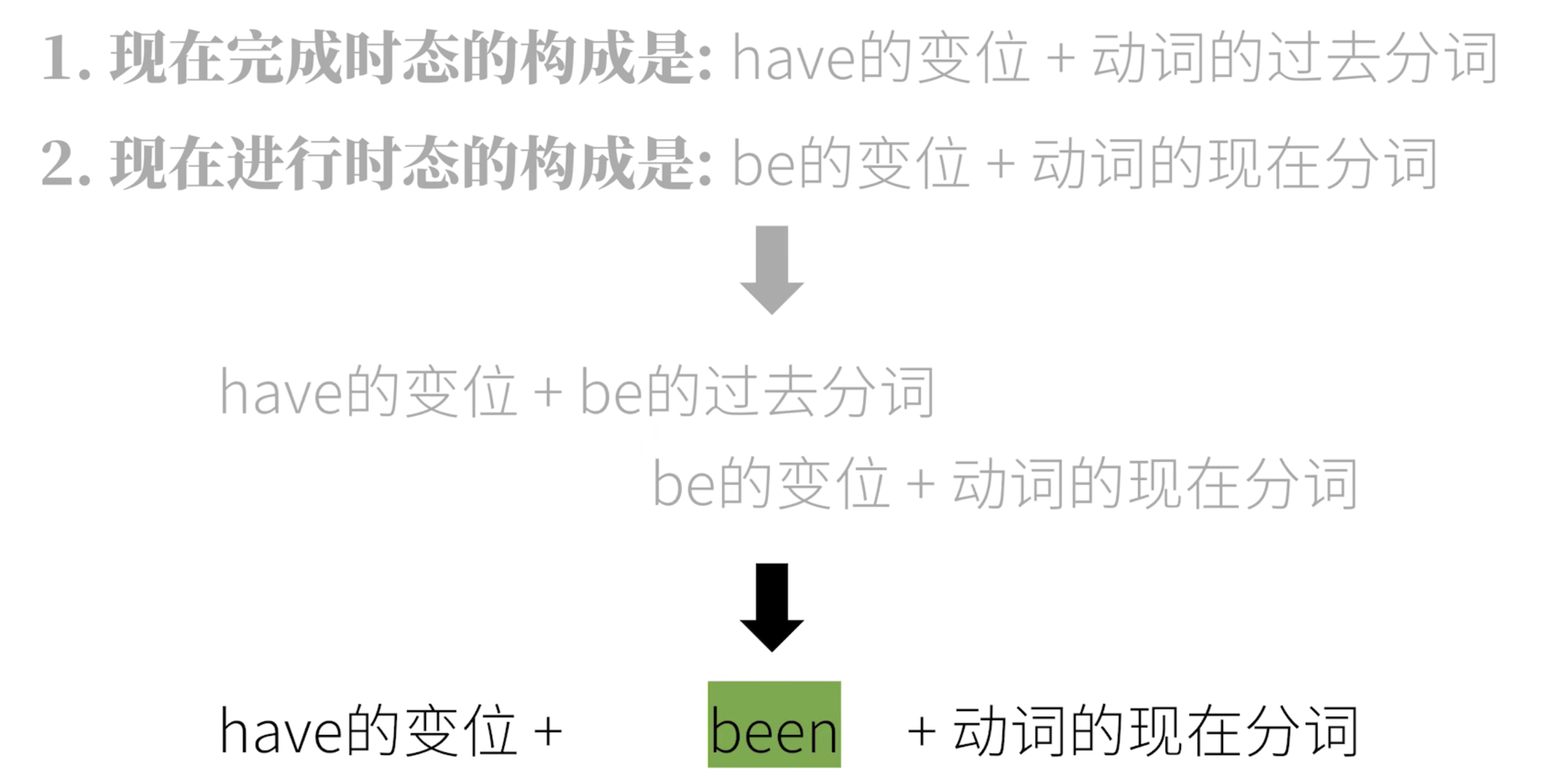
- 时态结构:助动词have的变位 + been + 动词的现在分词;此处have动词的变位是:have、has
例句:I have been eating carrots. 我在吃胡萝卜•(不但已经吃了些,还将继续)
- The rabbit has been eating a carrot.(这兔子到现在为止已经吃胡萝卜一段时间了,还要再继续吃段时间)
- You have been watching my video.(你到现在为止已经看了我视频一段时间了,还要再继续看一段时间)
- I have been thinking of you •(我到现在为止已经想你一段时间了,还要再继续想一段时间.)
结构图解

2、过去
①、一般过去时态
- 时态结构:+ 动词过去式 (各个人称的过去式都一样)
例句:I ate carrots
- The rabbit ate a carrot. 兔子吃了胡萝卜。(只知道这免子过去某个时刻在吃胡萝卜)
- You watched my video. 你看了我的视频。(可能的言下之意,这是事实,别抵赖哦)
- I thought of you. 我想子你(可能的言下之意,这是事实,不骗你)
动词的过去式
- 注意不要和动词的过去分词,时态的过去时混淆
- 动词过去式的变化一般也是在词尾加ed,还有部分不规则变化可以在不规则动词变化“规律”查阅
一般过去时表示某种习惯时,可以用词组used to
- 一般现在时:I play basketball
- 一般过去时:I used to play basketball
②、过去进行时态
- 时态结构:助动词be的变位 + 动词的现在分词;此处be动词的变位是:was、were
例句:I was eating a carrot;
- The rabbit is eating a carrot. ≥ The rabbit was eating a carrot. (这兔子在过去某个时间点处在正在吃胡萝卜的过程中)
- You are watching my video. ≥ You were watching my video.(你在过去某个时间点处在看我的视频的过程中)
- I am thinking of you. ≥ I was thinking of you.(我在过去某个时间点处在想你的过程中)
助动词be用来构建时态时的动词变位
- You/we/they were
- I/She/he/it was
③、过去完成时态
- 时态结构:助动词have的变位 + 动词的过去分词;此处have动词的变位是:had
- 时态解释:过去的过去都过去的影响;在现在完成时态的基础上将时间往前推,have/has > had
例句:I had eaten carrots;
- I had eaten 5 carrots for lunch yesterday, so I wasn't hungry at all yesterday afternoon. 这里要表达的意思就是,对于昨天下午(时间点A来说,因为昨天下午的过去(时间点B,也就是中饭时间),我已经吃了一堆胡萝卜,所以B对A有影响-这个影响就是:我一点都不饿.
- He tried to find me yesterday afternoon, but I had already gone to Shanghai. 对于他试图找我那个时间点A(昨天下午)来说,A的过去某一点B(可能是昨天上午,或前天,没说明,但是肯定是昨天下午之前)我已经离开了,去上海了,所以B对A有影响——这个影响就是:他找不到我.
- The rabbit has eaten a carrot. > The rabbit had eaten a carrot. (这兔子在过去某个时间点已经吃了个胡萝卜) You have watched my video. > You had watched my video.(你在过去某个时间点已经看过了我的视频) I have thought of you. = I had thought of you.(我在过去某个时间点已经想过你了)
④、过去完成进行时态
- 时态结构:助动词have的变位 + been + 动词的现在分词;此处have动词的变位是:had
- 时态解释:在过去的某个时间已经完成了一部分,还要在那个时间点之后继续完成;在现在完成进行时的基础上将时间往前推,have/has > had
例句:I had been eating carrots. 我在吃胡萝卜•(我过去某个时间不但已经吃了些,还将继续)
- The rabbit has been eating a carrot. > The rabbit had been eating a carrot. (这兔子在过去某个时间点已经吃胡萝卜一段时间了,还要在过去那个时间点之后继续吃一段时间)
- You have been watching my video. > You had been watching my video. (你在过去某个时间点之前已经看了我视频一段时间了,还要那个时间点之后继续看一段时间)
- I have been thinking of you. ≥ I had been thinking of you. (我在过去某个时间点之前已经想你一段时间了,还要在那个时间点后继续想一段时间)
3、将来
〇、将来时态说明
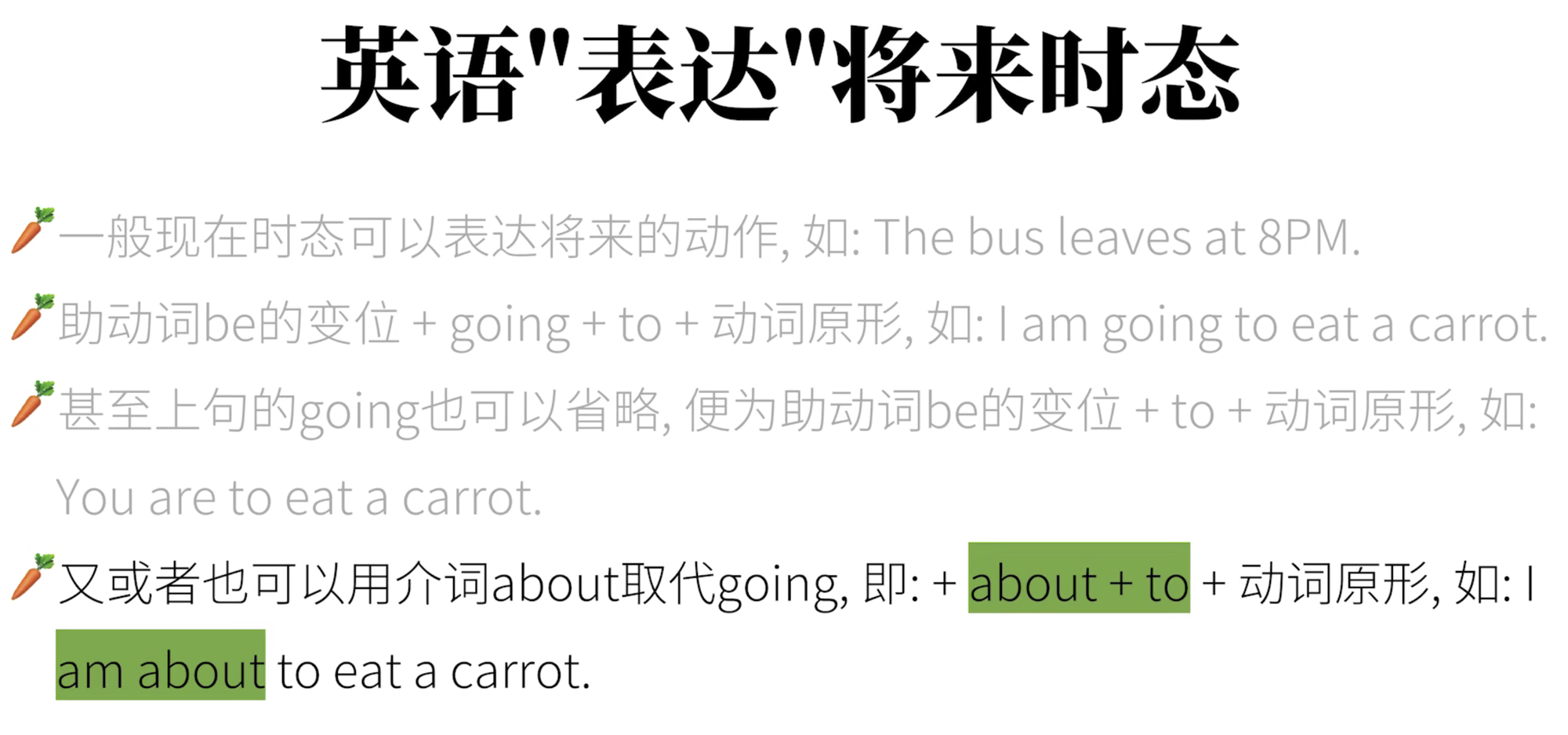
- 英语动词本身没有将来时态,只有将来时态的表达
- 接下来说的四个将来将来时态是需要在谓语动词之前加助动词才能表达将来——will、shall
- 当然也还有一些其他的表示将来时态的说法,如下:

①、一般将来时态
- 时态结构:will + 动词原型 (所有人称都用will)
- 例句:I will eat carrots
一般将来时态说明
- 描述将来某个时间点发生的动作(说话者十分确定会发生的事,如果不太确定某事会发生就不能用一般将来时了,要借助动词的语气)
- The sun will rise again tomorrow.太阳明天也会照常升起.
- I will definitely do my best to make high-quality videos.我以后也一定会尽全力做高质量视频.
②、将来进行时态
- 时态结构:will + be + 动词的现在分词
- 例句:I will be eating a carrot for lunch tomorrow
- 将来进行时态比一般将来时态还要笃定
③、将来完成时态
- 时态结构:will + have + 动词的过去分词
- 表达的意思比前两个更加笃定
例句:I will have eaten carrots by 4PM tomorrow
- I will have finished making the video by 4PM tomorrow, so I canpublish it after that.这里要表达的意思就是,对于明天下午4点钟那个时间点来说,我在那之前就会完成做视频这个动作,所以对4点钟那时候是有影响的一什么影响呢,4点钟之后我就能够发视频啦。
- If suddenly you forget me Do not look for me For I shall already have forgotten you 这里的I shall already have forgotten you就是将来完成时态,shal在这里相当于will.这句话意思是如果你将来忘记我的话,也没必要寻找我,因为,对于你将来忘记我的那个时间点来说,我已经在之前就忘记你了(完成了忘记你这个动作了)
- The rabbit has eaten a carrot. > The rabbit will have eaten a carrot. (这兔子在将来某个时间点已经吃了个胡萝卜)
- You have watched my video. > You will have watched my video. (你 在将来某个时间点已经看过了我的视频)
- Ihave thought of you. > I will have thought of you. (我在将来某个时 间点已经想过你了)
④、将来完成进行时态
- 时态结构:will + have + been + 动词的现在分词;此处have动词的变位是:had
例句:
- I will have been eating carrots for 2 hours by 3PM tomorrow. 这里要表达的意思就是:我确定明天下午三点钟时,我不但已经吃了俩钟头胡萝卜(也就是从明天下午1点开始吃)而且还要继续吃.
- You have been watching my video. > You will have been watching myvideo.(你在将来某个时间点之前已经看了我视频一段时间了,还要在那个时间点之后继续看一段时间)
- Ihave been thinking of you. > I will have been thinking of you. (我在 将来某个时间点之前已经想你一段时间了,还要在那个时间点后继续想 你一段时间)
4、过去将来
过去将来常常出现在从句中
①、一般过去将来时态
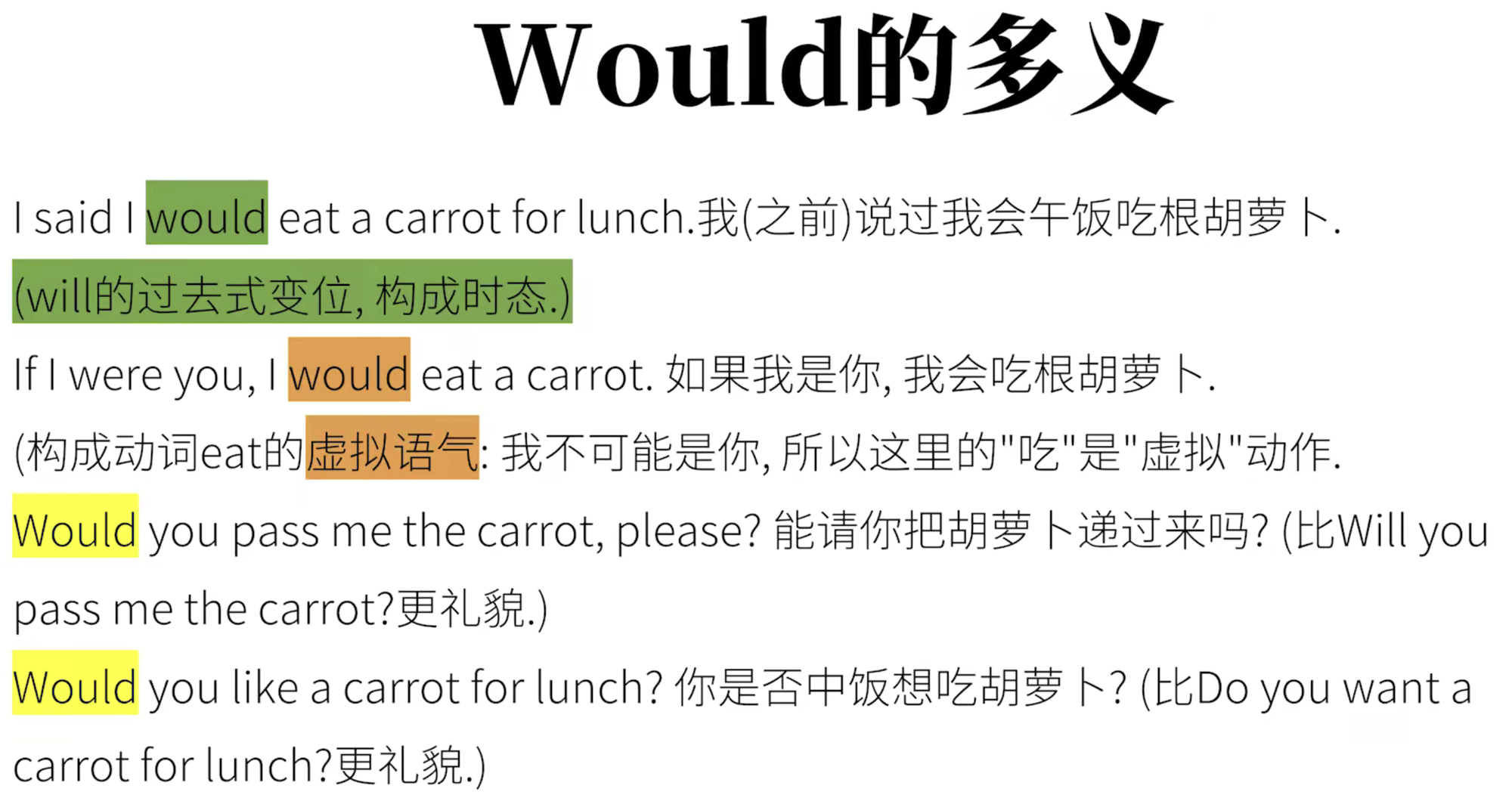
- 时态结构:would + 动词原型 (所有人称都用would)
例句:I would eat carrots
- I said I would eat a carrot for lunch. 我(之前)说过我会午饭吃根胡萝卜。 (午饭时间对于之前我说那话的时间来说是在将来,但至于现在午饭时间有没有到,不得而知)
- I knew you would watch my video. 我(之前)就知道你会看我的视频。 (你看我视频这件事多余我做出这个判断的时间来说是在将来.)
助动词be的变位 + going + to 也能表示过去将来时态
- I said I would eat a carrot for lunch. > I said I was going to eat a carrot for lunch.
- I knew you would watch my video. > I knew you were going to watch my video.
would的多义

②、过去将来进行时态
- 时态结构:would + be + 动词的现在分词
例句:
I said l would be eating a carrot at 1PM tomorrow/yesterday•
我(之前)说我明天下午1点会在吃胡萝卜.(我之前说我明天/昨天下午1点会是在吃胡萝卜这个过程中)
③、过去将来完成时态
- 时态结构:would + have + 动词的过去分词
例句:
I said I would have eaten a carrot by 1PM tomorrow/yesterday•
我(之前说我明天/昨天下午1点会已经吃掉了根葫萝卜.(我之前说我明天/昨天下午1点会已经做完了吃胡萝卜这个动作)
④、过去将来完成进行时态
- 时态结构:would + have + been + 动词的现在分词;此处have动词的变位是:had
例句:
I said I would have been eating lunch for 2 hours by 1PM tomorrow/yesterday•
我(之前)说我明天/昨天下午1点前会已经吃了俩钟头中饭•(我之前说我会明天/昨天下午1点时在吃中饭这个过程中,之
前吃了2钟头,之后还会继续吃。
5、易混概念对比
- 现在完成式 VS 一般过去时
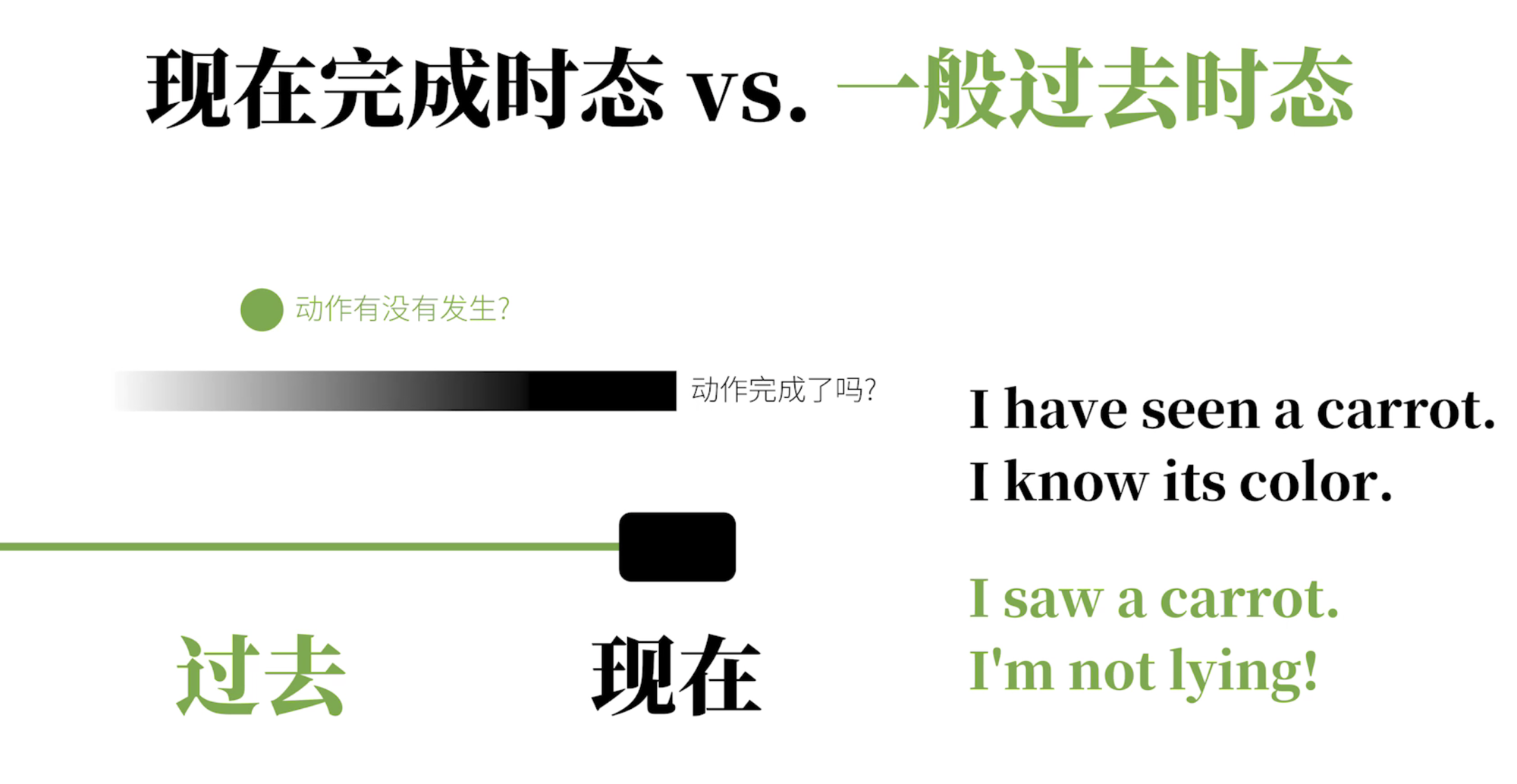

- 一般过去时 VS 过去进行时
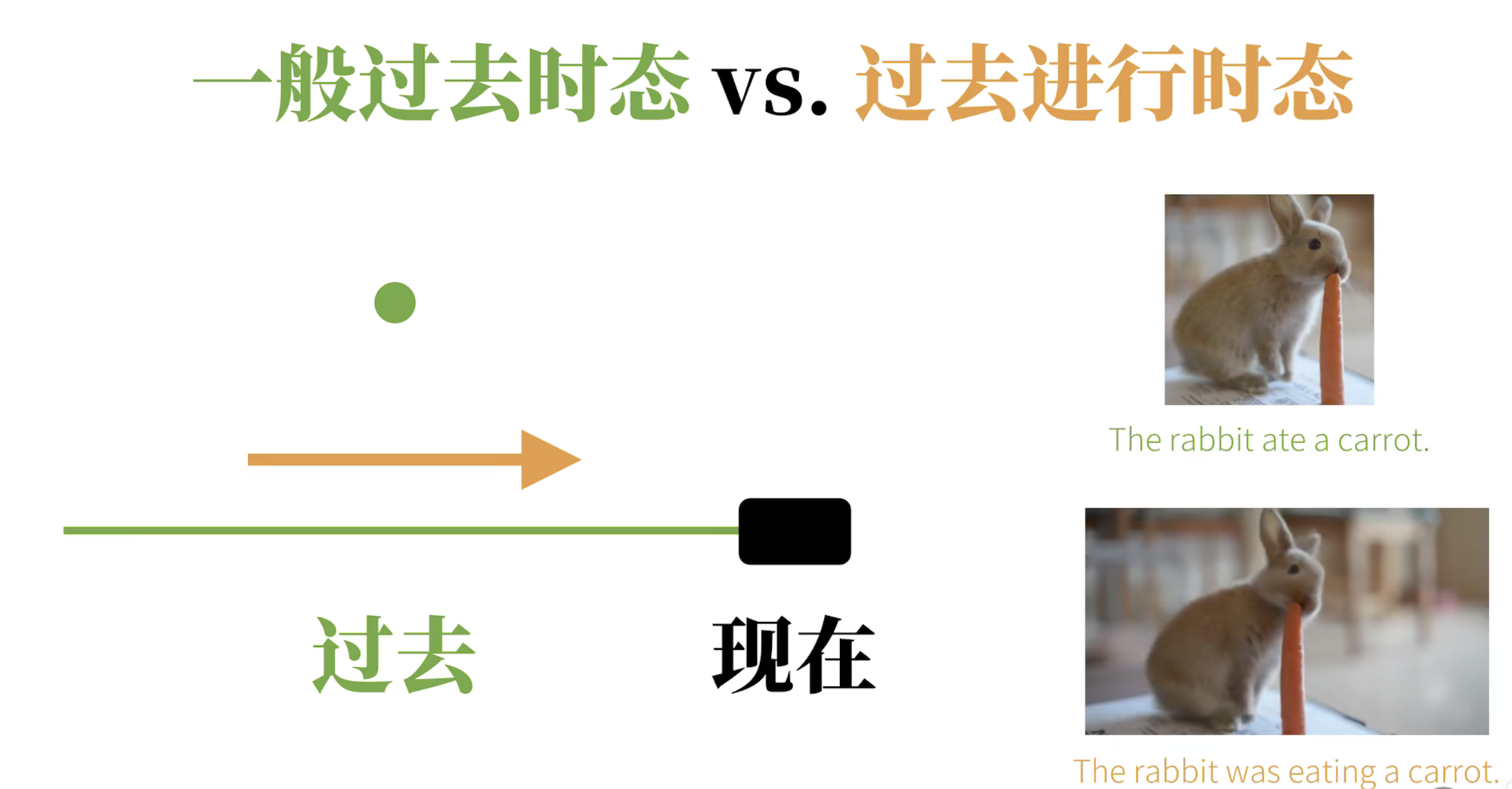
2.3、谓语动词的“语气”
1、陈述语气
- 描述现实
- The rabbit ate the carrot
2、祈使语气
- 命令/请求
- Rabbit,eat the ccarrot!
- 其实语句就是用第二人称“你” + 一般现在时态,然后去掉“你”并且动词用原型
- You eat the carrot —————— Eat the carrot
- You don’t eat it —————— Don’t eat it
- You are quiet —————— Be quier
- You never give up —————— Never give up
3、虚拟语气
1、表达“不可能”假设
①、和现在事实相反(描述希望发生但没发生的情况)
- If I swa the rabbit now, I would bite him.
- 结构:条件句中用过去式,主句中用would+动词原形
- 这里动词是过去式,但是并不表示过去时间;这里是描述现在的没发生但是希望发生的事,是想象的假设
②、和将来事实相反(描述将来很小可能性的动作)
- If I should see the rabbit tomorrow, I would bite him.
- 结构:条件句中用should+动词原形,主句中用whould+动词原形(should 也可以用 were to 替代)
- 条件句里虚拟语气动词的构成是:should+动词原型;主句中因为是假想,可能性很小,所以用woould
③、和过去事实想法(描述不可能的情况)
- 表示和过去已经发生的事实相反,不可能的情况
- 结构:条件句中用had+动词过去分词,主句中用whould have+动词过去分词
- If I had seen the rabbit a few days ago, I would have biten him.
2、表达愿望、请求、建议、命令等(希望某个动作/事件发生)
wish、would rather、demand、suggest、order、insist
①、对现在的希望:wish + 过去式
- I wish you where here.
②、对过去的希望:wish + had/(whould have) + 动词的过去分词
- I wish (that) I had eaten the carrot.
③、对将来的希望:wish + would/could/might + 动词原形(如果是其他词:demand/suggest/order/insist,那后面只能用 should并且should 可以省略)
- I wish (that) I could eat the carrot.
4、疑问语气(对陈述句进行提问)
- 对陈述语气的内容进行提问,改变语序或加助动车
- Did the rabbite eat the carrot?
- Was the rabbite hungry?
5、条件语气(句法结构和陈述句相同)
- 表示明天完全有可能看到那只兔子
- If I see the rabbit tomorrow, I will bite him.
6、感叹语气
7、总结
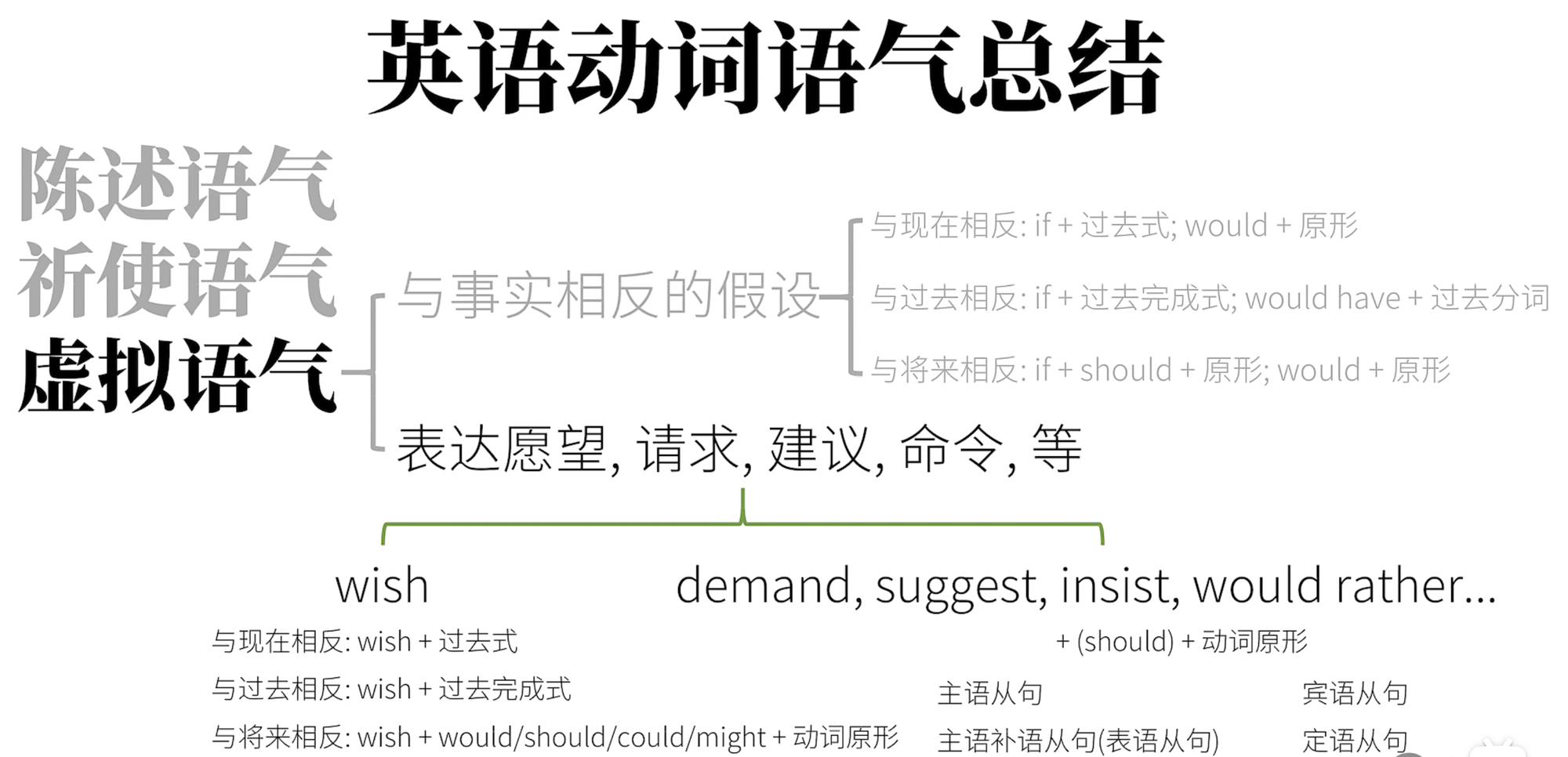
三、非谓语动词 Non-Finite Verbs
3.1、非谓语动词解释
- 谓语动词是句子的核心,而非谓语动词只可能出现在剩下的非核心部分。
- 非谓语动词也叫非限定性动词,非限定性动词不受主语的时间,状态,语气限制,是不被限定的词。
- 非谓语动词几乎可以取代所有的从句,从而简化句子;而此时的动词就不再具有表示时间、状态、语气、语态的功能。
3.2、非谓语动词的不同形式
非谓语动词能在一定程度上简化从句,言简意赅
3.2.1、动词不定式
1、动词不定式定义
- 不定式infinitive:来自拉丁文infinitus,无限。不受时间,人称等限制。
2、动词不定式形式
- 不定式的形式为:to + 动词原形(也称完全不定式full infinitive);有时to也会省略(也称裸不定式bare infinitive);
- to be or not to be, that is the question.
- you helped me (to)cook the carrot.
3、动词不定式充当句子成分
①、作主语
- to eat a carrot every day is good for the rabbit. 是谁吃,具体是过去吃,还是现在吃,光看to eat还不确定,所以才叫“不定式”,不受具体的时间,人物限制,单纯是表达一天吃一个胡萝卜的概念
- it is good for the rabbit to eat a carrot every day. it作为形式主语代替主语,
- 句型结构:it is + 形容词 + for sb. + to do sth.
- it is good that the rabbit eats a carrot every day. 主语从句,与上面的句子相当
②、作宾语
- the rabbit like to eat carrots.
- I consider it important to eat a carrot every day.I是主语,consider是复杂及物动词,it是形式宾语,import是宾语补足语,to eat a carrot every day是真正的宾语
③、作宾语补语
a、不定式可以可复杂及物动词一起使用
- the rabbit excepted the wolf to eat a carrot.
b、有些谓语动词(感官动词、使役动词)后面用不定式作宾补需要省略to
see、find、watch、have、make、let……
- carrot make the rabbit feel happy. 使役动词make后的不定式to feel,to被省略了。
c、部分谓语动词后接不定式作宾补时,省不省去to区别不大,都是正确表达
- the wolf helped the rabbit grow carrots.
- the wolf helped the rabbit to grow carrots.
④、作主语补语
- the rabbit’s dream is to eat every kind of carrot in the world.
⑤、作定语
- the rabbit has a lot of carrots to eat. 作后置定语,修饰carrots,表示这些胡萝卜是会被吃的,是一种动宾关系。
⑥、作状语
a、表原因
- I was surprised to get a thumbs-up. 我很吃惊(因为)得到一个赞。
- 原因状语从句:I was surprised because I got a thumbs-up.
b、表目的
- I will do anything to get a thumbs-up.
- 目的状语从句:I will do anything in order that I get a thumbs-up.
c、表结果
- I got enough thumbs-up to make another video.
- 结果状语从句:I got enough thumbs-up, so I made another video.
3.2.2、动名词
动名词的本质相当于名词,在动词原型后加ing(有的也会重复末尾字母),就能将动词转换成动名词;动名词与现在分词在形式上很相似,需注意区分
1、作主语
- 正常名词作主语:Carrots are healthy for the rabbit.
- 动名词(词组)作主语:Eating carrots is healthy for the rabbit.
2、作主语补语
- The rabbit’s hobby is growing carrots.
- Seeing is believing. 眼见为实
3、作定语
动名词作定语时,用来表明物体的属性,如性质,功能,用途等
- a sleeping pill 相当于 a pill for sleeping ; pill有助眠的功能
现在分词作定语时,用来描述物体的(所处的)状态
- a sleeping rabbit 不能写成
a rabbit for sleeping;兔子的状态在睡觉
4、作宾语
不定式和动名词都可以作宾语(谓语动词后的宾语),但是部分动词后不能用不定式作宾语,这时候可以用动名词
- 后不能接不定式作宾语的动词:enjoys, avoid, advise, consider, escape, mind, practice, insist on, give up, feel like, put off, ……
The rabbit enjoys to eat carrots.
- The rabbit enjoys eating carrots.
- The rabbit likes to eat carrots.
- The rabbit likes eating carrots.
当动词在介词后面作宾语时,需要将动词变换为动名词
- The rabbit is fond of eating carrots.动词短语,短语中of为介词
- The rabbit is looking forward to seeing the wolf again.动词短语,短语中to为介词,后接动词作宾语要用动名词
不定式和动名词作宾语的区别
- The rabbit stopped to eat a carrot. 兔子停下(手里的活)去吃一个胡萝卜
- The rabbit stopped eating a carrot. 兔子停止了吃胡萝卜
- The wolf forget to invite the carrot to her party.
- forget to do:表示忘记去做(还没有做)
- The rabbit forgot accepting the wolf’s invitation.
- forget doing:表示忘记做过(已经做过了)
3.2.3、现在分词
现在分词不具有“现在”这个时间属性,但是可以携带状态,本质相当于时一个形容词;常见的结构为:动词原形+ ing(有些活重复末尾字母)
1、作定语
现在分词作定语时,用来描述物体的(所处的)状态
- a sleeping rabbit 不能写成
a rabbit for sleeping;兔子的状态在睡觉
动名词作定语时,用来表明物体的属性,如性质,功能,用途等
- a sleeping pill 相当于 a pill for sleeping ; pill有助眠的功能
2、作主语补语(形容词:……的)
- The rabbit is charming.
- The story is interesting.
- The game is exciting.
- The news is encouraging.
3、作宾语补语(“正在”)
动名词作宾语补语表示动作正在发生,动词不定式作宾语补语表示动作的全程
- The wolf saw the rabbit eating a carrot.
- The wolf saw the rabbit eat a carrot. 感官动词后省略不定式的to
4、作状语
- Hearing the news, the rabbit became excited. —> When he hear the news, the rabbit became excited. 时间状语
- Not knowing what to eat, the rabbit skipped lunch. —> Because he didn’t know what to eat, the rabbit skipped lunch. 原因状语
3.2.4、过去分词
过去分词不具有“过去”这个时间属性,但是可以携带状态;常见的结构为:动词原形+ ed;也有很多不规则的过去分词变换,详见。
1、作定语:本质相当于时一个形容词
- (过去分词)作前置定语
- a minced carrot
- a painted room
- an excited rabbit
- (过去分词短语)作后置定语
- The carrot cake eaten by the rabbit is delicious.
2、作主语补语
- The rabbit is interested in groeing carrot. 动名词
- sb. is interested in doing sth.
- 现在分词作主语补语暗含主动关系,描述的是做出动作的人/物;过去分词作主语暗含被动关系,描述的是动作的接受者。
- The story is interesting. 故事(让人感到)有兴趣
- The rabbit is interested. 兔子(被某事某物)引起了兴趣
- The rabbit was frightened. 兔子感到害怕。
- The rabbit was frightening. 兔子令人感到害怕。
3、作宾语补语
- the rabbit found his carrot stolen
4、作状语
作状语时,用现在分词还是用现在分词,要看是主动还是被动
- Seen from the hill, the carrot field looks beautiful. 表地点
- Bron in a rabbit family, the rabbit has been growing carrots all his life. 表原因
- Given another chance, the rabbit would go to the wolf’s party. 表条件
3.2.5、独立主格
1、名词/代词 + 非谓语动词(不含动名词)
一个简单句,除去核心的谓语动词外,其他动词转为对应的过去分词或现在分词;分词修饰的对象隐含了一层主语的意味(但已经有了主语,所以称作主格)
- 名词/代词 + 现在分词 (动作和逻辑主语是主动或进行的关系)
- The weather permitting(现在分词), the rabbit will go out.
- If the weather permits, the rabbit will go out.
- 名词 + 过去分词 (动作和逻辑主语是被动或完成的关系)
- The work finished(过去分词), the rabbit went(谓语动词) home.
- 并列句:The work was finished, and/so the rabbit went home.
- 从句:After the work was finished, the rabbit went home.
- 名词 + 动词不定式(动作将要发生的动作)
- The rabbit to come, the wolf is overjoyed.
2、名词/代词 + being + 名词/形容词/副词/介词短语 (省略 being)
- 名词 + 名词
- Many animals went to the party, some of them rabbits and wolves.
- 名词 + 形容词
- Many animals went to the party, some of them happy.
- 名词 + 副词
- The rabbit sat on a chair, head down.
- 名词 + 介词短语
- The rabbit came in, carrot in hand.
3、with + 宾语 + 宾语补语(通常 with 可以省略)
- The work finished(过去分词), the rabbit went(谓语动词) home.
- With the work finished, the rabbit went home.
英语独立主格省略 with 后,还会进一步简化句子结构
- The rabbit came in, with a carrot in his hand.
- The rabbit came in, carrot in hand.
3.3、谓语动词充当句子成分总结
ㅤ | 作主语 | 作主语补语 | 作宾语 | 作宾语补语 | 作定语 | 作状语 |
动词不定式 | ✅ | ✅ | ✅ | ✅ | ✅ | ✅ |
动名词 | ✅ | ✅ | ✅ | ㅤ | ✅ | ㅤ |
动词现在分词 | ㅤ | ✅ | ㅤ | ✅ | ✅ | ✅ |
动词过去分词 | ㅤ | ✅ | ㅤ | ✅ | ✅ | ✅ |
- 不定式和动名词作宾语的区别:
- 不定式作宾语,表示动作还未发生(将要发生)。
- 动名词作宾语,表示动作已经发生。
- 不定式和现在分词作宾语补语的区别:
- 不定式作宾补,描述动作全过程
- 现在分词作宾补,表示动作正在进行
- 动名词和现在分词作定语的区别:
- 动名词作定语,描述物体的属性,如性质,功能,用途等
- 现在分词作定语,描述物体的状态
- 现在分词和过去分词作主语补语的区别:
- 现在分词作表语,暗含主动关系,描述的是做出动作的人或物
- 过去分词作表语,暗含被动关系,描述的是动作的接受者
四、助动词 Auxiliary Verbs
4.1、定义和特征
1、定义
谓语动词往往无法独立表达某些语法概念(时间状态语气等),需要其他词辅助,这些辅助词自身不能做谓语动词,这些词就是助动词,助动词还能帮助否定动词表达动词的被动,可能性,义务性等
- The rabbit will eat a carrot
2、特征
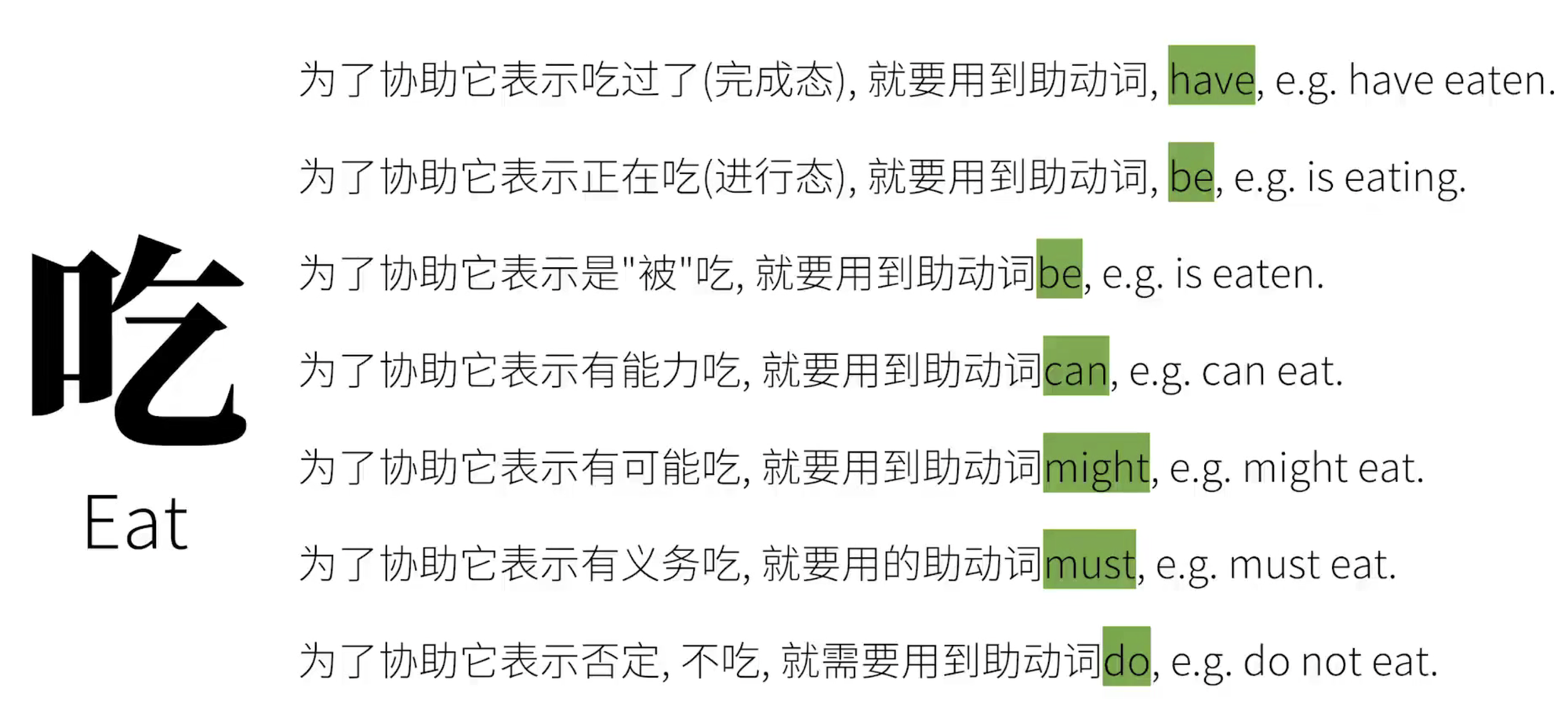
- 辅助主动词
- 不能像主动词那样单独作谓语动词

4.2、助动词的分类
1、基本助动词(作为助动词没有实际含义,作实义动词有实际含义)
- be 做实义动词译为:存在
- do 做实义动词译为:做
- have 做实义动词译为:有
2、情态助动词(情态助动词本身是有实际意义的,但是有些也可以当做实义动词来使用,且含义和作为助动词时可能不同)
- can/could
- may/might
- will/would
- shall/should
- must
- ought to
- dare/dared
- need
- used to
3、半助动词
- be able to
- be going to
- be about to
- had better
- ...
- the rabbit is able to / is going to / is about to / had better eat a carrot
4.3、基本助动词的应用
1、be
- The rabbit is eating a carrot. be——is辅助构成现在进行时态
- The carrot was eaten by the rabbit. be——was辅助构成被动
2、do
- the rabbit does like coins. do——does辅助构成强调
- the rabbit does not like freeloaders. do——does辅助构成否定
3、have
- the rabbit has eaten a carrot. have——has辅助构成现在完成式
4.4、情态助动词的应用
1、can/could
①、表能力
- I can kill a wolf
- I could kill a wolf last year
②、表请求或许可
- Can I borrow your book?
- Could I borrow your book? 这里could表示语气更委婉,更礼貌,更诚恳
③、表可能性
- Anything can happen
- Anything could happen. 可以表示过去的推测,也能表示现在的可能性(只不过表现在的时候可能性比can小)
- the rabbit could have gone home earlier, but didn’t finish work on time.(对过去的虚拟表达)
2、may/might
①、表请求或许可
- may I borrow your book? may比can/could礼貌
- might I borrow your book? might比may还要礼貌
②、表可能(可能性比can/could低),也许大概,可能
- the rabbit isn’t here, he may be at home.(如果用might暗示可能性更小)
③、表祝愿
表祝愿时通常放在句首,通常只用may
- May you succeed 祝你成功
3、must
①、表必须
- you must finish your homework first.
②、表禁止(和not连用)意思是“必须不”
- you must not smoke here
- 若要表示“非必需”
- you need not give me a thumbs-up
- you don’t have to give me a thumbs-up
③、表推测,意思是“一定,肯定”,只能用在肯定句
- the light is on. the rabbit must be at home.
- 若要表示否定的推测“不一定”
- the light isn’t on, the rabbit can’t be at home.灯不亮,兔子不可能在家
4、will/would
①、构成将来时
- the rabbit will eat a carrot
- the rabbit would eat a carrot
②、表请求,建议
- will you lend me that book? 你愿意借书给我吗
- would you please lend me that book? would表will更礼貌,更委婉
③、表推测,假设
- Ask him, He will/would know. 他可能知道,would的程度比will更弱
- what would the rabbit eat for dinner
- he would eat a carrot
5、shall/should 二者含义相差太大
①、shall
a、构成将来时
- I will be there at 9AM
- I shall be there at 9AM
b、表请求或征求意见
- shall we meet at 9AM.
c、表警告,命令
- you shall not pass
- you shall not murder. you shall not steal. you shall not covet
②、should
a、表应当
- we should treat the rabbit well.
b、表有一定根据的推测
- it should rain tomorow. 根据具体情况的推测,可能性较大
c、表“竟然”
- it’s surprising that he should be late
d、构成虚拟语气
- if it should rain tomorow, I wouldn’t go.
- you should have eaten the carrot.
6、ought to
①、表应该
与should表应该时大致相同,但程度更强
- we ought to treat the rabbit well
7、need
①、情态动词
- the rabbit need wait
- the rabbit need not wait
②、谓语动词
- the rabbit needs to wait
- the rabbit does not need to wait
8、dare
作情态动词时表示“敢”,一般用于否定句和疑问句中
- the rabbit dare not tell the truth to the wolf
- how dare you
9、used to
表示过去的动作,尤其是重复的动作,强调和现在的对比
- the rabbit used to eat apples, now he only eats carrots. 兔子过去(习惯)池苹果,现在他只吃胡萝卜
used to / use / be used to 区分
- could i use your phone
- i am used to getting up early
4.5、半助动词的应用
1、be able to 表能力
- i’ll be able to reach school on time if i leave right now. 如果我现在就离开就能按时到学校(表将来的能力)
- i was able to reach school on time because i left home early. 因为我离家很早所以按时到校(表过去的能力时,was/were able to……,表示成功做成……)
2、be going to / be about to / be to 表示将要做某事
- be going to,计划做某事,很快就要做某事
- i’m going to eat dinner at 6PM today
- be about to,要做某事的时间更短
- be to,表示被命令作某事
- you are to finish home work first
- i think they’re to fall in love with each other. 我想他们注定会相爱(被命运命令)
3、had better(’d better) 表忠告,警告,“最好做……”(如果不做会有不好的结果)
- you had better follow my orders.
五、不规则动词变化“规律”
